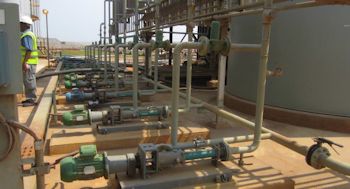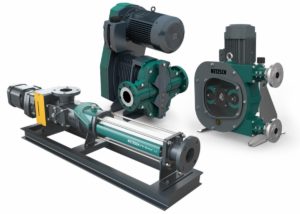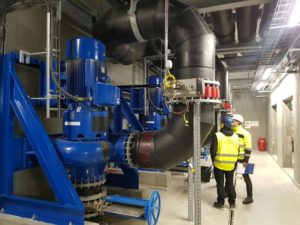Aggressive Gold Sludge: Special Pump Technology from Netzsch Delivers Long Service Life
Global demand for gold and silver remains as high as ever. Precious metals are not only sought after by investors, but are indispensable materials in modern industry. However, mining these resources places machines under extreme stress and can increase the already high price of the raw material even further.

As the pumps are speed-controlled, it was possible to determine the ideal speed using a frequency inverter and thereby minimise wear and tear without the risk of medium being deposited in the pump. (Source: Netzsch Pumpen & Systeme GmbH)
The sludge of crushed, gold-bearing stone that is transported for chemical extraction, for example, is extremely abrasive and can destroy pumping systems within a few days. Adding water does make it possible to convey the product, but also increases the effort required in the gold concentration process. Nemo progressing cavity pumps from Netzsch Pumpen & Systeme GmbH are increasingly used to save on maintenance and process costs, as they are capable of with-standing the valuable yet problematic medium thanks to smooth pumping technology and exceptionally robust components.
Both silver and gold are normally only available as small particles and therefore have to be mined with the surrounding stone. The precious metal can then be separated from the crushed material matrix using a variety of different methods, including cyanide leaching and amalgamation with mercury. However, the mixture must first be condensed and concentrated, so the water content of the stone-gold sludge should ideally be no more than 40 percent. In the past, centrifugal pumps were typically used in the mining industry for this conveying step, although centrifugal pumps are in fact designed for fluids and therefore require a medium that is at least 50 percent water. Additional water was injected to operate these pumps, although the water made subsequent extraction more difficult.
Material damage caused by abrasive stone in the gold sludge
In search of alternatives, a rotary lobe pump was installed in a mining region on a trial basis. However, the pump housing was completely destroyed within just two days. The high abrasiveness of the gold sludge was to blame. The stone particles in the sludge behave like sandpaper, particularly at high speeds, and wear away all surfaces extremely quickly – until the system fails completely. This effect can only be reduced by particularly smooth pumping at a economically viable volume, as further tests with a Nemo progressing cavity pump demonstrated.
A progressing cavity pump operates with a combination of rotor and stator. The helix rotor rotates within a stator jacket fitted to the rotor with a reversed helix to form conveying chambers with the same shape between the two components. The medium is conveyed in these chambers from the suction to the discharge side without pulsation, shear forces or changes in pressure. As even viscous substrates and substrates containing a large proportion of solid matter can be reliably conveyed in this way, only a limited amount of water needs to be added to the gold sludge. It was therefore possible to reduce the water content of the stone-gold sludge from more than 50% to close to the target 40%.
Robust materials, low speed and smooth pumping reduce wear and tear
To achieve a system with as long a service life as possible, despite heavy wear, the designers at Netzsch selected tungsten carbide for the rotor. Tungsten carbide, with a scratch hardness of 9.5 on the Mohs scale, is almost as hard as diamond and is therefore scarcely affected by the grinding of the crushed stone. SBE, a nitrile material, was used for the stator. It is similarly extremely wear resistant, but also soft enough to prevent the points of contact with the rotor from wearing out too quickly.
An additional advantage of this pump technology in the specific application was the availability of speed control. The rotor speed can be adjusted with complete flexibility via a variable frequency inverter, so it was possible to determine the perfect speed across a number of test runs. The aim was to find a balance between as low a surface speed as possible to reduce abrasion and a sufficient throughput to prevent the medium from settling. The 20 hp motor was shifted down, first to 189 rpm, then finally to 130 rpm. At that speed, the system conveys a total of 10 m³/h at 9 bar pressure.
Increased life cycle despite lower proportion of water
The progressing cavity pumps are also low power consumers and are easy to clean and maintain, which in turn reduces operating and maintenance costs. However, it is the durability of the pumps which is decisive when it comes to conveying gold. In the first test, the pump ran for three months without damage to the stator or rotor. The mine operator has since installed a further three Nemo pumps with an average service life of approximately 3.5 months. The service life exceeds the life cycle of earlier centrifugal pumps, which were completely worn out after three months, despite the addition of water.







